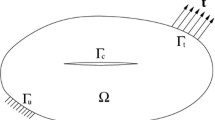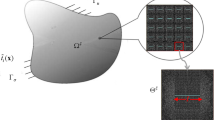Abstract
The numerical manifold method combined with the virtual crack extension method is proposed to study the mixed mode fracture propagation. The manifold method is a new numerical method, and it provides a unified framework for solving problems dealing with both continuums and jointed materials. This new method can be considered as a generalized finite element method and discontinuous deformation analysis. One of the most innovative features of the method is that it employs both physical mesh and mathematical mesh to formulate the physical problem. These two meshes are separated and independent. They are inter-related through the application of weighting functions. A local mesh refinement and auto-remeshing schemes previously proposed by the authors are adopted in this study. The proposed model is first verified by comparing the numerical stress intensity factors with the benchmark solutions, and the results show satisfactory accuracy. The maximum tangential stress criterion is adopted and the mixed mode fracture propagation problems are then fully investigated. The numerical solutions by the present method agree well with the experimental results.
Similar content being viewed by others
References
Arrea, A. and Ingraffea, A.R. (1982). Mixed-Mode Crack Propagation in Mortar and Concrete. Report No. 81-13, Cornell University, Ithaca, N.Y.
Banks-Sills, L. and Sherman, D. (1986). Comparison of methods for calculating stress intensity factors with quarter-point elements. International Journal of Fracture 32, 27–140.
Belytschko, T., Lu, Y.Y. and Gu, L. (1994). Element-free Galerkin methods. International Journal for Numerical Methods in Engineering 37, 229–256.
Belytschko, T., Lu, Y.Y. and Gu, L. (1995). Crack propagation by element-free Galerkin methods. Engineering Fracture Mechanics 51, 295–315.
Bittencourt, T.N., Waarzynek, P.A., Ingraffea, A.R. and Sousa, J.L. (1996). Quasi-automatic simulation of crack propagation for 2D LEFM problems. Engineering Fracture Mechanics 55, 321–334.
Cain, G.L. (1994). Introduction to General Topology, Addision Wesley, New York.
Chan, S.K., Tuba, I.S. and Wilson, W.K. (1970). On the finite element method in linear fracture mechanics. Engineering Fracture Mechanics 2, 1–s17.
Chen, G., Ohnishi, Y. and Ito, T. (1998). Development of high-order manifold method. International Journal for Numerical Methods in Engineering, 43, 685–712.
Doblare, M., Espiga, F., Gracia, L. and Alcantud, M. (1990). Study of crack propagation in orthotropic materials by using the boundary element method. Engineering Fracture Mechanics 37, 953–967.
Demkowicz, L., Oden, J.T., Rachowicz, W. and Hardy, O. (1989). Toward a universal h-p adaptive finite element strategy, part 1. Constrained approximation and data structure. Computer Methods in Applied Mechanics and Engineering 77, 79–112.
Erdogan, F. and Sih, S.C. (1963). On the crack extension in plates under plane loading and transverse shear. Journal of Basic Engineering ASME 85, 519–525.
Ghorbanpoor, A. and Zhang, J. (1990). Boundary element analysis of crack growth for mixed-mode center slant crack problems. Engineering Fracture Mechanics 36, 661–668.
Hellen, T.K. (1975). On the method of virtual crack extensions. International Journal for Numerical Methods in Engineering 9, 187–207.
Hillerborg, A., Modeer, M. and Petersson, P.E. (1976). Analysis of crack formation and crack growth in concrete by means of fracture mechanics. Cement and Concrete Research 6, 773–782.
Hussain, M.A., Pu., S.L. and Underwood, J. (1974). Strain energy release rate for a crack under combined mode I and mode II. Fracture Analysis, ASTM STP 560, 2–28.
Ishikawa, H. (1980). A finite element analysis of stress intensity factors of combined tensile and shear loading by only a virtual crack extension. International Journal of Fracture 16, 243–246.
Leitao, V.M.A., Aliabadi, M.H., Rooke, D.P. and Cook, R. (1998). Boundary element methods for the analysis of crack growth in the presence of residual stress fields. Journal of Materials Engineering and Performance 7, 352–360.
Lim, I.L., Johnston, I.W. and Choi, S.K. (1996). A finite element code for fracture propagation analysis within elasto-plastic continuum. Engineering Fracture Mechanics 53, 193–211.
Lu, Y.Y., Belytschko, T. and Tabbara, M. (1995). Element-free Galerkin method for wave propagation and dynamic fracture. Computer Method in Applied Mechanics and Engineering 126, 131–153.
Mi, Y. and Aliabadi, M.H. (1994). Three-dimensional crack growth simultation using BEM. Computer & Structures 52, 871–878.
Nayroles, B., Touzot, G. and Villon, P. (1992). Generalizing the finite element method: diffuse approximation and diffuse elements. Computation Mechanics 10, 307–318.
Paris, P.C. and Sih, G.C. (1965). Stress analysis of cracks. ASTM STP 381, 1–30
Parks, D.M. (1974). A stiffness derivative finite element technique for determination of crack tip stress intensity factors. International Journal of Fracture 10, 487–502.
Sha, G.T. (1984). On the virtual work extension technique for stress intensity factors and energy release rate calculations for mixed fracture mode. International Journal of Fracture 25, 33–42.
Sha, G.T. and Yang, C.T. (1990). Use of analytically decoupled near tip displacement solutions for calculating the decoupled weight functions of mixed fracture modes. Engineering Fracture Mechanics 37, 591–610.
Shi, G.H. (1988). Discontinuous deformation analysis: a new numerical method for the static and dynamics of block systems. Ph.D. Dissertation, Department of Civil Engineering, University of California, Berkeley, U.S.A.
Shi, G.H. (1995). Numerical manifold method. Working Forum on the Manifold Method of Material Analysis 2, 1–180.
Sih G.C. (1973). Mechanics of Fracture. Volume 1: Method of Analysis and Solution of Crack Problem, Noordhoff International Publishing, Leiden.
Sih G.C. (1974). Strain-energy-density factor applied to mixed crack problems. International Journal of Fracture 10, 305–321.
Tada, H., Paris, P.C. and Irwin, G.R. (1973). The Stress Analysis of Cracks Handbook, Del Research Corporation, Hellertown, Pennsylvania, U.S.A.
Tsay, R.J., Chiou, Y.J. and Chuang, W.L. (1999). Crack growth prediction by manifold method. Journal of Engineering Mechanics ASCE 125, 884–890.
Williams, M.L. (1957). On the stress distribution at the base of a stationary crack. Journal of Applied Mechanics ASME 79, 109–114.
Xie, M., Gerstle, W.H. and Rahulkumar, P. (1995). Energy-based automatic mixed-mode crack-propagation modeling. Journal of Engineering Mechanics ASCE 121, 914–923.
Author information
Authors and Affiliations
Rights and permissions
About this article
Cite this article
Chiou, YJ., Lee, YM. & Tsay, RJ. Mixed mode fracture propagation by manifold method. International Journal of Fracture 114, 327–347 (2002). https://doi.org/10.1023/A:1015713428989
Published:
Issue Date:
DOI: https://doi.org/10.1023/A:1015713428989




